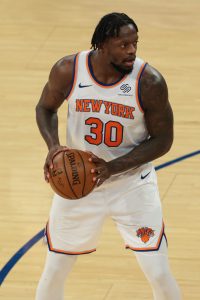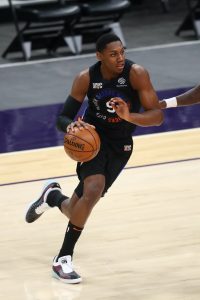No NBA team outperformed its preseason expectations more significantly in the 2020/21 season than the Knicks, who were projected by oddsmakers to be in the mix for the league’s worst record. Instead, New York, buoyed by a Julius Randle breakout year and the influence of new head coach Tom Thibodeau, claimed a top-four seed in the East by finishing with a 41-31 record.
 The Knicks’ first-round series vs. Atlanta exposed some of the deficiencies that the team was able to mask during the regular season, and Thibodeau’s club made a quick postseason exit, losing to the Hawks in five games. But it was still a massively successful year for a franchise that hadn’t made the playoffs or even finished above .500 since 2013.
The Knicks’ first-round series vs. Atlanta exposed some of the deficiencies that the team was able to mask during the regular season, and Thibodeau’s club made a quick postseason exit, losing to the Hawks in five games. But it was still a massively successful year for a franchise that hadn’t made the playoffs or even finished above .500 since 2013.
While some regression should perhaps be expected in 2021/22, the Knicks are well-positioned to avoid taking a step backward by adding reinforcements to their core group, which includes Randle and rising forward RJ Barrett. New York will have more cap space than any other NBA team and has extra first-round picks both this year and in the future, making the club a threat to be a player in free agency or on the trade market.
The Knicks are still a ways off from title contention, but for the first time in years, there are legitimate reasons to be optimistic about the team’s future.
The Knicks’ Offseason Plan:
Although the Knicks are in a good spot to add outside help to their roster, many of their most important decisions will be made on their own players.
Randle, for instance, was once considered a candidate to be waived before his full 2021/22 salary became guaranteed. That’s no longer a realistic outcome. Instead, the Knicks will have to decide whether to offer him an extension that could have a base value worth up to $106MM+ over four years (plus incentives) and Randle will have to decide whether to accept it.
If New York believes Randle’s improvements – particularly his three-point percentage – are sustainable, offering that extension certainly makes sense for the team. Of course, if Randle believes the same thing, he’d be justified in turning down such an offer in the hopes of securing a more lucrative contract as a free agent in 2022.
Randle’s future will in turn impact that of 2020 lottery pick Obi Toppin, who had an underwhelming rookie year, in large part because he wasn’t a great fit in lineups that featured Barrett and Randle. If the Knicks are committed to Randle long-term, Toppin could become a trade chip.
The Knicks also face an important decision on Mitchell Robinson, who has a non-guaranteed minimum salary for 2021/22. Typically, guaranteeing that salary and perhaps exploring a contract extension would be the obvious move for the club. But if Robinson reaches free agency in 2022, he’ll be an unrestricted free agent. If New York turns down his team option, he’d be a restricted free agent this summer, giving the team more control in locking him up going forward.
The Knicks will have to determine whether Robinson, who was limited to 31 games this season due to a right foot injury, is a crucial part of their future. If he is, they’ll have to figure out what the best approach is for making sure he’s around for the long haul.
Finally, the Knicks face decisions on several veteran free agents, including key role players like Derrick Rose, Alec Burks, Nerlens Noel, and Reggie Bullock. All of those vets could be in line for raises after strong seasons in New York, so the team will have to weigh which of its free agents are worth more substantial investments and which should be cut loose in search of a better bargain.
We haven’t even gotten yet to the upgrades the Knicks may pursue outside of the organization, but their options should be plentiful. In recent years, the organization has been unable to attract top free agents to New York due to the club’s poor play and questionable leadership. But the Knicks’ 2020/21 success and the stability that Thibodeau and president of basketball operations Leon Rose have brought to the franchise have helped boost the team’s appeal.
That doesn’t mean the Knicks will be able to go out and add Kawhi Leonard or Chris Paul, but it does mean that free agency could be a more viable path to adding an impact player than it has been in recent years. That’s especially true given New York’s financial flexibility — if the team wants to outbid rival suitors for a veteran free agent such as Kyle Lowry, Mike Conley, or Spencer Dinwiddie, it has the ability to do so.
That cap flexibility will also help grease the wheels for potential trades. For example, while I don’t view Collin Sexton as a perfect fit in New York, there are rumors that the team has been the most aggressive trade suitor for him so far. The Knicks’ financial flexibility could allow them to take on Kevin Love‘s oversized contract as part of a Sexton deal, or to comfortably negotiate a long-term extension for the high-scoring guard. Again, I’m not sure either of those moves is in New York’s best interest, but those are the kinds of possibilities that cap space helps create.
Of course, in their first year with substantial cap room available in 2020, Rose and the Knicks’ front office took a more conservative approach, prioritizing short-term, team-friendly deals for undervalued players like Burks and Noel.
It’s possible the team could go that route again if there are no favorable opportunities to take a bigger swing. But after the Knicks’ success in 2020/21, I imagine the front office will feel a little more pressure – including perhaps from Thibodeau – to add the types of players who can help the club take another step forward in ’21/22.
Salary Cap Situation
Note: Our salary cap projections are based on a presumed 3% increase, which would result in a $112.4MM cap for 2021/22.
Guaranteed Salary
 RJ Barrett ($8,623,920)
RJ Barrett ($8,623,920)- Joakim Noah ($6,431,667) — Waived via stretch provision.
- Kevin Knox ($5,845,978)
- Obi Toppin ($5,105,160)
- Julius Randle ($4,000,000) — Partial guarantee. Non-guaranteed portion noted below. 1
- Immanuel Quickley ($2,210,640)
- Total: $32,217,365
Player Options
Team Options
Non-Guaranteed Salary
Restricted Free Agents
Two-Way Free Agents
Draft Picks
- No. 19 overall pick ($2,770,560)
- No. 21 overall pick ($2,553,120)
- No. 32 overall pick (no cap hold)
- No. 58 overall pick (no cap hold)
- Total: $5,323,680
Extension-Eligible Players
- Kevin Knox (rookie scale)
- Julius Randle (veteran)
- Mitchell Robinson (veteran)
Unrestricted Free Agents / Other Cap Holds
- Derrick Rose ($9,987,804): Early Bird rights
- Alec Burks ($7,200,000): Non-Bird rights
- Elfrid Payton ($6,197,100): Early Bird rights
- Nerlens Noel ($6,000,000): Non-Bird rights
- Reggie Bullock ($5,460,000): Early Bird rights
- Taj Gibson ($1,669,178): Early Bird rights
- Total: $36,514,082
Offseason Cap Outlook
Locking in Randle’s salary would result in about $50MM in guaranteed salaries for five roster spots. From there, the Knicks could go a number of ways in filling out their roster.
If we assume the team picks up Robinson’s option and keeps its two first-round picks while waiving or renouncing everyone else, that’d result in nearly $52MM in cap space. Adding Rose’s cap hold would bring that cap room projection down to $42.5MM; adding Noel’s cap hold would reduce it to about $37.5MM, and so on. Trading one or both of their first-round picks could slightly increase the team’s space.
Essentially, even if the Knicks do want to try to bring back two or three of their free agents, they’ll be able to generate enough cap room for a maximum-salary contract or close to it. It’s a safe bet they’ll operate under the cap this offseason rather than over it.
Cap Exceptions Available
- Room exception: $4,910,000 3
Footnotes
- Randle’s salary becomes fully guaranteed after July 31.
- Robinson will be eligible for restricted free agency if his option is declined.
- This is a projected value.
Salary and cap information from Basketball Insiders, RealGM, and ESPN was used in the creation of this post.
 The Knicks’ first-round series vs. Atlanta exposed some of the deficiencies that the team was able to mask during the regular season, and Thibodeau’s club made a quick postseason exit, losing to the Hawks in five games. But it was still a massively successful year for a franchise that hadn’t made the playoffs or even finished above .500 since 2013.
The Knicks’ first-round series vs. Atlanta exposed some of the deficiencies that the team was able to mask during the regular season, and Thibodeau’s club made a quick postseason exit, losing to the Hawks in five games. But it was still a massively successful year for a franchise that hadn’t made the playoffs or even finished above .500 since 2013.